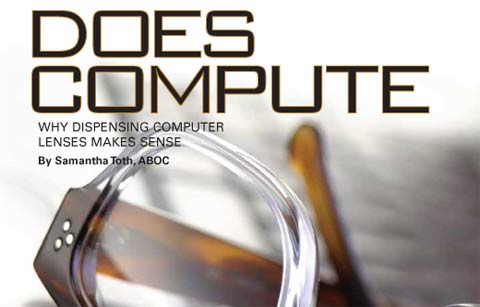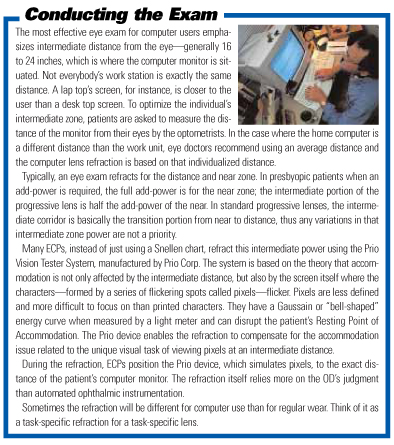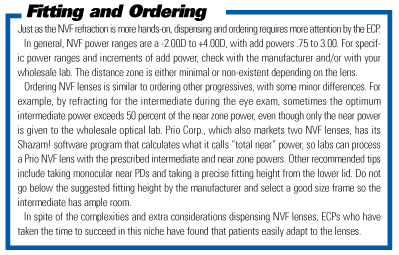
Computer eyewear sales provide eyecare professionals with one of the greatest opportunities for practice growth today. According to the U.S. Census, 143 million adults use a computer every day and an estimated 54 million children use a computer at home and/or school. The American Optometric Association estimates that 70 to 75 percent of all computer users experience Computer Vision Syndrome (CVS) symptoms including headaches and eyestrain.
Although many computer users can benefit from computer eyewear, presbyopic Baby Boomers are an obvious target. Baby Boomers now comprise approximately 35 percent of the American population and are a large percentage of the American population experiencing blurred vision in the near and intermediate vision zones with the onset of presbyopia. The oldest Boomers are entering their 60s, and the youngest are at least 43 years old, which means most are already presbyopes or are about to become presbyopic.
While the majority of CVS complaints seem to come from presbyopes, hyperopes can also have accommodative issues with the intermediate zone that a regular prescription will not correct.
Also, a growing number of children are using computers and could benefit from computer eyewear. According to the National Center for Education Statistics (NCES) in 2004, about 90 percent of children and adolescents ages five to 17 use computers at school or at home. The NCES also reports that computer use begins at a very early age. About three-quarters of five-year-olds now use computers.
The combination of the intermediate zone and the monitors cause what appears to be unique accommodative issues to children. When they stop looking at the screen, they will often have problems focusing. Children may not be able to articulate their CVS symptoms, but parents will notice some changes in behavior such as a drop in grades. The optical solution for CVS, known clinically as asthenopia, is Near-Variable Focus (NVF) lenses, a specialized progressive lens design featuring a wide intermediate corridor to optimize vision for computer use. Computer users who require a prescription can have more problems accommodating in the intermediate. Computer lenses can be a solution for these patients.
Special eyewear prescribed for computer work and other near tasks can help these patients maintain proper focus on the computer screen with less eye fatigue. The lens power in these near variable focus (NVF) lenses will make the computer screen clear and more comfortable to read for prolonged periods of time. Also, NVF lenses typically feature a wide intermediate corridor. Since computer users who require a prescription can have more problems accommodating in the intermediate, this is a particularly helpful design feature.
Unfortunately, many patients believe that because they already own one pair of eyewear they do not need a separate pair of computer glasses. This assumption can be corrected by implementing the total vision care approach with the patient. In most practices, initial contact with the patient begins on the phone. The staff member scheduling the appointment should request the patient brings their computer eyewear with them to their appointment. If the patient says they do not have a pair to bring, the staff member should make a note in the file so the doctor and dispensing optician are aware of this.
The total vision care approach continues with the intake of the patient. The staff member checking in the patient should ask if they brought their computer eyewear with them. If they did, that eyewear should be secured for professional review. It should be inspected and neutralized to assure the prescription is optimal for near and intermediate zones of vision.
Also during this review the patient should be asked to complete a visual needs analysis (VNA) form including questions about the patient’s lifestyle, hobbies and previous pair of eyewear to identify the patient as a candidate for computer eyewear. This form should be quick and easy to fill-out using mostly objective check boxes. The completed form should then be reviewed by the doctor.
While the patient is in the reception area, it is important to have information and signage available illustrating the importance of computer eyewear. Short videos are available focusing on the features and benefits of computer eyewear. Waiting-room information often leads to questions the patient can then ask the doctor during their examination.
During the actual eye examination, it is important for the doctor to review the VNA form with the patient to determine whether or not they would be a candidate for computer eyewear or another form of supplemental eyewear. By asking questions and establishing a dialogue with the patient about their lifestyle and hobbies, the doctor shows a genuine concern for the patient and can better identify vision needs not currently being met by their primary pair of eyewear. When applicable, the doctor should translate the visual needs expressed by the patient into the recommendation of computer eyewear. This component of the total vision care approach is vital as 25 percent of patients reported to the Vision Council of America (VCA) in 2006 that they purchased their lenses based on the doctor’s recommendation.
 This total vision care approach continues in
the dispensary incorporating both the
patient’s primary pair of eyewear, computer
eyewear and other vision care product and
service needs. Since computer eyewear has
already been discussed, the patient is unlikely
to feel surprised with the “sticker shock”
sometimes associated with supplementary
pairs of eyewear. This enables the patient to
learn about the best products available to
meet their vision requirements.
This total vision care approach continues in
the dispensary incorporating both the
patient’s primary pair of eyewear, computer
eyewear and other vision care product and
service needs. Since computer eyewear has
already been discussed, the patient is unlikely
to feel surprised with the “sticker shock”
sometimes associated with supplementary
pairs of eyewear. This enables the patient to
learn about the best products available to
meet their vision requirements.Once the patient has picked-up their primary eyewear and computer eyewear, following up with the patient reinforces the total vision care approach. Calling the patient or sending a letter within one week lets them know there is help for them if they have any questions about their new eyewear. This follow- up assures them your concern is for more than just “the sale.” In addition, it provides a great opportunity to ask for referrals of friends or co-workers who may also have a need for computer eyewear.
It is important to explain to all patients that specialized computer eyewear can be worn to optimize vision in the near and intermediate distance and allow for a more natural head position. Standard progressive lenses only have a small portion of the lens that corrects for the intermediate and reading zone. Without proper computer eyewear, many standard progressive lens wearers experience the symptoms of CVS. Even worse, many try to compensate for blurred vision by leaning or tipping their head back in an effort to see the computer screen clearly. This poor ergonomic posture can result in a sore neck, sore shoulders and a sore back.
 In addition to allowing for better ergonomic
posture, computer lenses also provide a
more comfortable viewing area that is longer
and wider in the intermediate and near zones
of vision. Many patients are receptive to
purchasing computer eyewear when they
fully understand the features and benefits
they will experience that are not present in
their primary pair of eyewear.
In addition to allowing for better ergonomic
posture, computer lenses also provide a
more comfortable viewing area that is longer
and wider in the intermediate and near zones
of vision. Many patients are receptive to
purchasing computer eyewear when they
fully understand the features and benefits
they will experience that are not present in
their primary pair of eyewear.All computer eyewear should include an anti-reflective (AR) coating. Premium AR coatings keep light from reflecting off the lens surfaces, thereby preventing an additional source of glare. Studies show that people who work for prolonged periods at a computer find their eyes are more comfortable if they wear lenses with AR coating (compared to wearing the same lenses without the coating). AR coatings also make the lenses easier to clean and more resistant to scratching. Utilizing the total vision care approach, offices can be more effective in presenting the features and benefits of computer eyewear to patients, while enjoying an increase in practice growth and patient satisfaction.
With over 12 years of experience in the optical industry, Samantha Toth, president of Innereactive Media in Grand Rapids, Mich., provides optical marketing lectures and seminars. Her eight years of dispensing experience as an ABO-certified optician coupled with a marketing degree provide a unique perspective on marketing private practices and optical labs. For more information call Innereactive Media at (616) 682-9370.











